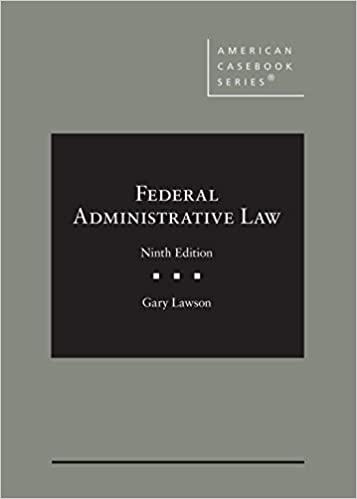Question
Prosecution for murder against D for the killing of X. Question 7 (1 point) The prosecution, in its case-in-chief, introduces an eyewitness, E, to testify
Prosecution for murder against D for the killing of X.
Question 7 (1 point)
The prosecution, in its case-in-chief, introduces an eyewitness, E, to testify that two years before the alleged killing of X, D had killed one M in a brawl over the affections of a woman. The defense objection to this testimony should be
Question 7 options:
| |||
| |||
| |||
|
Question 8 (1 point)
D, in his defense, takes the stand and testifies that X attacked him first and that he only killed X in self-defense. On cross, P asks him: "Were you, on or about December 29, 2010, convicted of the felony of perjury?" D's objection should be
Question 8 options:
| |||
| |||
| |||
|
Question 9 (1 point)
In rebuttal, the prosecution offers to show that D's reputation in the community where he resides for truth and veracity is bad. D's objection to this offer should be
Question 9 options:
| |||
| |||
| |||
|
Question 10 (1 point)
Theory of P is that D first raped X, then choked her to death by tying her hands with twine and wrapping a nylon stocking around her neck. In its case in chief, P offers to show that on three previous occasions, within the past three years, D committed other rapes, each time choking his victim with a nylon stocking and binding her hands with twine. D's objection to this offer would probably be:
Question 10 options:
| |||
| |||
| |||
|
The defendant is charged with murder, alleged to have occurred last year. The defense is self-defense. As part of the defendant's case-in-chief, the defendant calls a witness who will testify that the defendant's reputation for peacefulness is good. This is the defense's first witness. The prosecution on cross examination then intends to ask the witness: (1) "did you hear that the defendant beat up another man at a tavern one year ago?", and (2) "did you hear that the defendant was convicted of a misdemeanor assault last year? The correct ruling on the admissibility of these questions is:
Question 11 options:
| |||
| |||
| |||
|
Question 12 (1 point)
Plaintiff has sued the defendant for slander. Plaintiff testifies that the defendant, before several other persons, said: "Plaintiff is a crook and a cheat." The defendant denies making the statement and that, in any event, the statement is true. In the defense case, defendant offers evidence that (1) the plaintiff's reputation for honesty is bad, and (2) that one month before the alleged slander, the plaintiff had sold the defendant a defective car. The proper ruling on the admissibility of these offers is:
Question 12 options:
| |||
| |||
| |||
|
If, during ultimately unsuccessful settlement negotiations in a car accident case, the defendant's attorney admits that her client's car had damaged steering, evidence of the condition of the defendant's car's steering mechanism may be admitted at trial to show negligence, but evidence of the defense attorney's statement may not.
Question 13 options:
| A) True | |
| B) False |
Question 14 (1 point)
Extrinsic evidence relevant to show the bias of a witness who has testified in a case is never rejected on the ground that it violates the general principle that forbids the introduction of extrinsic evidence on collateral matters.
Question 14 options:
| A) True | |
| B) False |
Question 15 (1 point)
Where character itself is not in issue but character evidence is admissible to show action in accord with character, the evidence proving character is usually limited to evidence of a reputation for the character trait in question.
Question 15 options:
| A) True | |
| B) False |
Question 16 (1 point)
The original writing or "best evidence rule applies to recordings, photographs, and writings, but not videos.
Question 16 options:
| A) True | |
| B) False |
Question 17 (1 point)
The quickest way to authenticate an official publication of the United States government is through the testimony of the person who wrote or edited the publication.
Question 17 options:
| A) True | |
| B) False |
Question 18 (1 point)
In deciding preliminary factual questions that determine whether an item of hearsay evidence is admissible because it is within a recognized exception, the judge is not bound by the hearsay rule.
Question 18 options:
| A) True | |
| B) False |
Question 19 (1 point)
W, an eyewitness, testifies at D's preliminary hearing on murder charges, but D's attorney decides to ask no questions on cross examination. W dies before trial. The prosecution may, consistent with the confrontation clause, present a properly authenticated videotape of W's preliminary hearing testimony at D's murder trial.
Question 19 options:
| A) True | |
| B) False |
Question 20 (1 point)
To show that the declarant offered the proponent $3000 a carload for widgets, evidence of the declarant's out-of-court statement to the proponent "I offer you $3000 for your widgets is hearsay.
Question 20 options:
| A) True | |
| B) False |
Step by Step Solution
There are 3 Steps involved in it
Step: 1

Get Instant Access to Expert-Tailored Solutions
See step-by-step solutions with expert insights and AI powered tools for academic success
Step: 2

Step: 3

Ace Your Homework with AI
Get the answers you need in no time with our AI-driven, step-by-step assistance
Get Started


